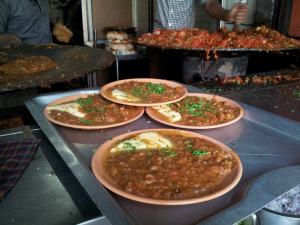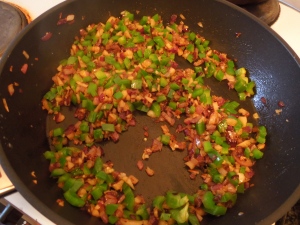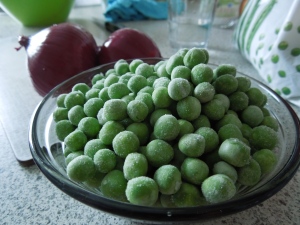 So I have told you all about Mumbai’s beautiful markets and hazy sunsets, but I think that it’s about time that I share a recipe for one of the city’s most beloved creations.
So I have told you all about Mumbai’s beautiful markets and hazy sunsets, but I think that it’s about time that I share a recipe for one of the city’s most beloved creations.
Pav Bhaji is a dish savored by both elders and youngsters alike. Translating literally to “bread and vegetables”, this dish consists of a pot of mashed, fried vegetables simmered away until browned in a hot blend of spices. It’s served with warm puffy, slightly sweet rolls, slathered in loads of butter. In fact, pav bhaji itself takes a departure from most Indian dishes  because even the vegetables are cooked in butter, so much so that if you visit certain street side stalls in Mumbai, such as the popular Sardar’s of Tardeo, you’re likely to find your pav bhaji floating in butter!
because even the vegetables are cooked in butter, so much so that if you visit certain street side stalls in Mumbai, such as the popular Sardar’s of Tardeo, you’re likely to find your pav bhaji floating in butter!
This unhealthy deluge is perfectly acceptable because pav bhaji is street-food after all. Popular all through out the year, be it in the hot and dry summers, crisp and cool winters, or wet and humid monsoons, pav bhaji satisfies the fast-food cravings of practically any Mumbai resident. It’s deeply satisfying, and no matter what condition you may be in, pav bhaji is sure to make your day or night.
Beyond the street, pav bhaji is also enjoyed greatly in the home. It’s the ultimate one pot meal, and whenever I’m in  Mumbai, my favorite pav bhaji to savour is not the kind found on the streets, but the one made lovingly by my dadi (grandmother). While all of her food is pure exceptional, it is nearly impossible to resist her pav bhaji and it has almost become a tradition (at least in the last couple visits) to enjoy it as a final meal before leaving Mumbai.
Mumbai, my favorite pav bhaji to savour is not the kind found on the streets, but the one made lovingly by my dadi (grandmother). While all of her food is pure exceptional, it is nearly impossible to resist her pav bhaji and it has almost become a tradition (at least in the last couple visits) to enjoy it as a final meal before leaving Mumbai.
The popularity of pav bhaji in the home can also probably be due to the fact that it is such a snap to make! While we traditionally make most of our masalas from scratch when preparing a dish, pav bhaji is one of those exceptions where practically every Indian will have a store-bought spice mix already sitting in the fridge. It’s one of those spice blends we simply take for granted and expect to be the same almost everywhere. Furthermore, as it is fast food, we want this to be on the table and in our bellies fast! However, in case you are wondering, common spices in a pav bhaji masala include coriander, cumin, green mango, cardamom, black pepper, dried ginger, mace, nutmeg, and lots and lots of chili powder. There of course some fresh flavors at play here too. Copious amounts of garlic do add a distinct hotness, and the final garnishing of minced red onion, chopped cilantro, and squeeze of lime juice adds notes of crunchiness, freshness, and that ubiquitous sourness that’s associated with almost all Indian street foods. Finally, I can’t forget the butter now, can I? Depending on how you make it, the butter in pav bhaji can either be in your face, or a more subtle yet lingering feeling of richness that sticks with you as the pav bhaji travels down your throat and leaves you feeling all warm and happy on the inside. That’s how I like it, and I hope you will too when you venture into the kitchen and create this beautiful bit of Mumbai within your home.
Ingredients (Bhaji):
- 3 large or 6 medium potatoes
- 1 cup peas
- 1 large red onion, chopped fine
- 1 green bell pepper, chopped
- 14 oz can of chopped tomatoes
- 8 plump garlic cloves, minced
- 1 jalapeno pepper, minced
- 1/2 teaspoon ground turmeric
- 2-3 tablespoons pav bhaji masala (adjust depending on how much heat you want)
- salt to taste
- lots of butter! 🙂
For the Pav:
- about 1 dozen rolls (In India special bread rolls are baked just for this dish, but in the US, I find that seedless hamburger buns work perfectly)
- salted butter
For the Garnishings:
- 1 small red onion, finely minced
- 1/4 cup fresh cilantro, finely chopped
- 2 limes, chopped into about eight wedges each
Method:
In a medium pot, boil the potatoes until they are tender. You will know they are ready when a knife inserted into the  middle goes through easily without much resistance. During the final 10 minutes of the cooking time, throw in the peas and allow them to cook with potatoes. Then drain these vegetables and peel the potatoes. Chop them up into small chunks.
middle goes through easily without much resistance. During the final 10 minutes of the cooking time, throw in the peas and allow them to cook with potatoes. Then drain these vegetables and peel the potatoes. Chop them up into small chunks.
In a large saucepan, heat a generous amount of butter (about 4 tablespoons) over medium-high heat. When the butter is melted, add the onion and saute for about 5 minutes, until the onion is softened and beginning to brown. Then add the garlic and cook for another minute. Add  the bell pepper and jalapeno and cook for another 2-3 minutes. You can also add another couple pats of butter at this point if you’d like. Then add the turmeric and pav bhaji masala and stir around for about a minute, till the spices have begun to release their aromas. Add the chopped tomatoes and cook out the mixture for about 10 minutes, stirring frequently until the vegetables are browned and the butter has separated from the vegetables at the sides of the pan. Add the potatoes and peas and begin to mash the mixture vigorously with a potato masher until the potatoes have reached the consistency of mashed potatoes. Cook out the pav bhaji for about 5-10 minutes, allowing the flavors to mingle. Season to taste to salt. Bear in mind that most pav bhaji masalas already contain salt, so you may not need to add as much as you think.
the bell pepper and jalapeno and cook for another 2-3 minutes. You can also add another couple pats of butter at this point if you’d like. Then add the turmeric and pav bhaji masala and stir around for about a minute, till the spices have begun to release their aromas. Add the chopped tomatoes and cook out the mixture for about 10 minutes, stirring frequently until the vegetables are browned and the butter has separated from the vegetables at the sides of the pan. Add the potatoes and peas and begin to mash the mixture vigorously with a potato masher until the potatoes have reached the consistency of mashed potatoes. Cook out the pav bhaji for about 5-10 minutes, allowing the flavors to mingle. Season to taste to salt. Bear in mind that most pav bhaji masalas already contain salt, so you may not need to add as much as you think.
For the pav, slather the rolls (and I really do me slather) with butter on both sides and toast them in a pan until golden brown.
To serve the dish, present the bhaji warm with plenty of minced red onion, chopped cilantro, and lime wedges for garnishing, along with the hot buttered rolls for scooping up the vegetables.
Cooking Notes:
- Pav Bhaji Masala can be found in all Indian grocery stores as well as larger supermarkets.
- It’s important that you use REAL butter in this recipe. It is one of the key ingredients, and it does in fact lend a distinct flavor note to the dish. Using margarine, a butter substitute, or oil will simply not give you the same result. Think of this recipe as a way to indulge once in a while.
- Depending on how spicy you would like your Pav Bhaji to be, adjust the amount of Pav Bhaji masala you use accordingly. If you would like a more mild version, add about 1.5 to 2 tablespoons of the masala. If you want a spicy pav bhaji, put in 3 tablespoons of the masala.
- The kinds of vegetables you put in Pav Bhaji is entirely up to you! The masala is quite versatile and as everything is mashed up in the end, this a great way to sneak in vegetables which your guests or children might not normally like. Standard ingredients in pav bhaji include potatoes, peas, onions, and tomatoes, but feel free to add cauliflower, green beans, squash, baby corn, mushrooms, etc. The sky’s the limit with this one. I just wouldn’t recommend adding any meat though. That wouldn’t be a good mix.

One thought on “A Mumbai Masterpiece: Pav Bhaji”